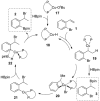Copper-catalyzed recycling of halogen activating groups via 1,3-halogen migration
- PMID: 22985198
- PMCID: PMC4490833
- DOI: 10.1021/ja306446m
Copper-catalyzed recycling of halogen activating groups via 1,3-halogen migration
Abstract
A Cu(I)-catalyzed 1,3-halogen migration reaction effectively recycles an activating group by transferring bromine or iodine from a sp(2) to a benzylic carbon with concomitant borylation of the Ar-X bond. The resulting benzyl halide can be reacted in the same vessel under a variety of conditions to form an additional carbon-heteroatom bond. Cross-over experiments using an isotopically enriched bromide source support intramolecular transfer of Br. The reaction is postulated to proceed via a Markovnikov hydrocupration of the o-halostyrene, oxidative addition of the resulting Cu(I) complex into the Ar-X bond, reductive elimination of the new sp(3) C-X bond, and final borylation of an Ar-Cu(I) species to turn over the catalytic cycle.
Figures
Similar articles
-
1,3-Halogen migration as an entry to aryl coppers from an unintuitive starting material.Org Biomol Chem. 2014 Oct 21;12(39):7655-8. doi: 10.1039/c4ob01294a. Epub 2014 Aug 19. Org Biomol Chem. 2014. PMID: 25136932
-
Formal Asymmetric Hydrobromination of Styrenes via Copper-Catalyzed 1,3-Halogen Migration.Chem Sci. 2014 Dec 1;5(12):4763-4767. doi: 10.1039/C4SC02040E. Chem Sci. 2014. PMID: 26167268 Free PMC article.
-
Proposal for halogen atom transfer mechanism for Ullmann O-arylation of phenols with aryl halides.Dalton Trans. 2012 Dec 7;41(45):13832-40. doi: 10.1039/c2dt31500a. Epub 2012 Aug 28. Dalton Trans. 2012. PMID: 22929985
-
Recent advances in copper-catalyzed dehydrogenative functionalization via a single electron transfer (SET) process.Chem Soc Rev. 2012 May 7;41(9):3464-84. doi: 10.1039/c2cs15323h. Epub 2012 Feb 20. Chem Soc Rev. 2012. PMID: 22349590 Review.
-
Electrophilic halogenation-reductive elimination chemistry of organopalladium and -platinum complexes.Acc Chem Res. 2015 Feb 17;48(2):238-47. doi: 10.1021/ar500325x. Epub 2015 Jan 20. Acc Chem Res. 2015. PMID: 25602260 Review.
Cited by
-
Mechanistic Insight Facilitates Discovery of a Mild and Efficient Copper-Catalyzed Dehydration of Primary Amides to Nitriles Using Hydrosilanes.J Am Chem Soc. 2018 Feb 7;140(5):1627-1631. doi: 10.1021/jacs.8b00643. Epub 2018 Jan 29. J Am Chem Soc. 2018. PMID: 29353477 Free PMC article.
-
Highly diastereo- and enantioselective CuH-catalyzed synthesis of 2,3-disubstituted indolines.J Am Chem Soc. 2015 Apr 15;137(14):4666-9. doi: 10.1021/jacs.5b02316. Epub 2015 Apr 6. J Am Chem Soc. 2015. PMID: 25826004 Free PMC article.
-
Enantio- and regioselective CuH-catalyzed hydroamination of alkenes.J Am Chem Soc. 2013 Oct 23;135(42):15746-9. doi: 10.1021/ja4092819. Epub 2013 Oct 15. J Am Chem Soc. 2013. PMID: 24106781 Free PMC article.
-
Mechanistic studies of copper(I)-catalyzed 1,3-halogen migration.J Am Chem Soc. 2015 Apr 29;137(16):5346-54. doi: 10.1021/ja511236d. Epub 2015 Apr 16. J Am Chem Soc. 2015. PMID: 25828031 Free PMC article.
-
Cascade intramolecular Prins/Friedel-Crafts cyclization for the synthesis of 4-aryltetralin-2-ols and 5-aryltetrahydro-5H-benzo[7]annulen-7-ols.Beilstein J Org Chem. 2021 Jun 22;17:1481-1489. doi: 10.3762/bjoc.17.104. eCollection 2021. Beilstein J Org Chem. 2021. PMID: 34239615 Free PMC article.
References
-
- Negishi Ei, de Meijere A., editors. Handbook of Organopalladium Chemistry for Organic Synthesis. Wiley; New York: 2002.
- de Meijere A, Diederich F, editors. Metal-Catalyzed Cross-Coupling Reactions. 2nd. Wiley-VCH; Weinheim: 2004.
-
-
Selected reviews of C-H functionalization: Mkhalid IA, Barnard JH, Marder TB, Murphy JM, Hartwig JF. Chem Rev. 2010;110:890.Lyons TW, Sanford MS. Chem Rev. 2010;110:1147.Engle KM, Mei TS, Wasa M, Yu JQ. Acc Chem Res. 2012;45:788.Neufeldt SR, Sanford MS. Acc Chem Res. 2012;45:936.Song G, Wang F, Li X. Chem Soc Rev. 2012;41:3651.Ackermann L. Chem Rev. 2011;111:1315.Davies HML, Morton D. Chem Soc Rev. 2011;40:1857.Wendlandt AE, Suess AM, Stahl SS. Angew Chem Int Ed. 2011;50:11062.
-
-
- Bedford RB, Coles SJ, Hursthouse MB, Limmert ME. Angew Chem Int Ed. 2003;42:112. - PubMed
- Ihara H, Suginome M. J Am Chem Soc. 2009;131:7502. - PubMed
- Robbins DW, Boebel TA, Hartwig JF. J Am Chem Soc. 2010;132:4068. - PubMed
- Dai HX, Stepan AF, Plummer MF, Zhang YH, Yu JQ. J Am Chem Soc. 2011;133:7222. - PubMed
- Huang C, Chattopadhyay B, Grevorgyan V. J Am Chem Soc. 2011;133:12406. - PMC - PubMed
- Gulevich AV, Melkonyan FS, Sarkar D, Gevorgyan V. J Am Chem Soc. 2012;134:5528. - PMC - PubMed
-
-
Recent examples of activating group recycling: Newman SG, Lautens M. J Am Chem Soc. 2011;133:1778.Hooper JF, Chaplin AB, González-Rodríguez C, Thompson AL, Weller AS, Willis MC. J Am Chem Soc. 2012;134:2906.
-
Publication types
MeSH terms
Substances
Grants and funding
LinkOut - more resources
Full Text Sources
Other Literature Sources
Research Materials





